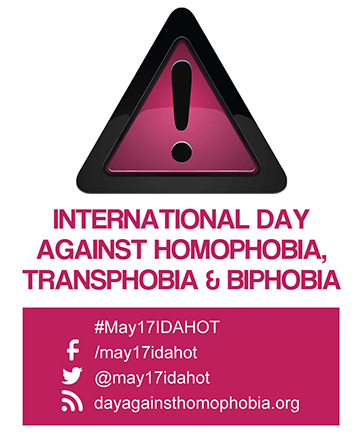
- This event has passed.
International Day Against Homophobia, Transphobia & biphobia
17/05/2016
A global celebration of sexual and gender diversities
 An annual landmark to draw the attention of decision makers, the media, the public, opinion leaders and local authorities to the alarming situation faced by lesbian, gay, bisexuals, transgender and intersex people and all those who do not conform to majority sexual and gender norms.
An annual landmark to draw the attention of decision makers, the media, the public, opinion leaders and local authorities to the alarming situation faced by lesbian, gay, bisexuals, transgender and intersex people and all those who do not conform to majority sexual and gender norms.
May 17 is now celebrated in more than 130 countries, including 37 where same-sex acts are illegal, with 1600 events reported from 1280 organizations in 2014. These mobilisations unite millions of people in support of the recognition of human rights for all, irrespective of sexual orientation or gender identity or expression.
The International Day Against Homophobia, Transphobia and Biphobia is not one centralised campaign; rather it is a moment that everyone can take advantage of to take action.
The date of May 17th was specifically chosen to commemorate the World Health Organization’s decision in 1990 to declassify homosexuality as a mental disorder.
The International Day against Homophobia, Transphobia and Biphobia has received official recognition from several States, international institutions as the European Parliament, and by countless local authorities. Most United Nations agencies also mark the Day with specific events.
Note on the name
May 17 was first known as the “International Day against Homophobia” and mainstreamed through its acronym “I.DA.HO”
In 2009, Transphobia was added explicitly in the title of the name, in the recognition of the very different issues at stake between sexual orientation and gender expression. “IDAHOT” became another popular acronym used alongside the initial one. Since 2015, biphobia has been added to the title, to acknowledge the specific issues faced by bisexual people.
To ensure even more inclusion and reflect the diversity of sexual and gender minorities, we have created at global level the baseline “A global celebration of sexual and gender diversities”.
Explanation from the IDAHOT website
